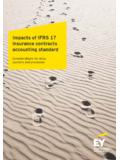Transcription of The Sarbanes-Oxley Act at 10 - Ernst & Young
1 The Sarbanes-Oxley Act at 10. Enhancing the reliability of financial reporting and audit quality Twelve years ago, the US capital markets were roiled by revelations of financial wrongdoing at numerous major companies. The damage to investors, pensioners, communities and markets was historic. Corporate executives were jailed. One of the nation's largest companies and one of the largest audit firms went out of business. After hundreds of corporate earnings restatements, confidence in financial markets was shaken to the core. To restore public confidence in the reliability of financial reporting, the US Senate and House of Representatives passed the Sarbanes-Oxley Act of 2002, by votes of 99-0 and 423-3, respectively, sending it to President George W. Bush, who signed the reform measure into law on July 30, 2002.
2 Since its enactment, the Sarbanes-Oxley Act, or SOX as it is often called, has been both heralded and maligned. EY believes it is important to consider what the Act was actually designed to do and to revisit the significance of its impact. SOX was designed to enhance the reliability of financial reporting and to improve audit quality. At EY, we believe it has done both; although, more work surely remains. SOX forged a new era for the US audit profession by ending over 100 years of self-regulation and establishing independent oversight of public company audits by the Public Company Accounting Oversight Board (PCAOB). SOX strengthened corporate governance, shifting responsibility for the external auditor relationship away from corporate management to independent audit committees. It instituted whistleblower programs, CEO and CFO certification requirements and stricter criminal penalties for wrongdoing, including lying to the auditor.
3 These measures and others were geared toward improving the reliability of corporate financial reporting. Over the last 12 years, key elements of the Act have been replicated around the world, perhaps the purest form of flattery. Today, as we turn the corner on the global financial crisis, many jurisdictions are looking anew at policy improvements similar to those instituted by SOX. To be sure, Sarbanes-Oxley has received its share of criticism over the years, the bulk of which has focused on Section 404 relating to internal controls over financial reporting. Such concerns have been addressed since the passage of SOX through a series of regulatory and legislative actions, including changes enacted in 2012. At EY, we believe history has shown, and will continue to show, that the Sarbanes-Oxley Act as a whole has afforded a substantial benefit to investors and US capital markets.
4 We believe that one of the greatest successes of the Sarbanes-Oxley Act was to align the interests of auditors, independent audit committees and audit oversight authorities with those of shareholders. In our view, as the 10th anniversary of the Sarbanes-Oxley Act approaches, the Act continues to provide a solid foundation from which to further this alignment. This document reviews the Act's key provisions, perspectives on some improvements engendered by SOX and opportunities for further enhancements to the financial reporting system. James S. Turley Steve Howe Former Global Chairman and CEO, Americas Managing Partner and Managing 2001-2013 Partner of the US Firm Principal components of the Sarbanes-Oxley Act of 2002. I. Established independent oversight of public company audits Established the PCAOB, which ended more than 100 years of self-regulation by the public company audit profession Provided the PCAOB with inspection, enforcement and standard-setting authority II.
5 Strengthened audit committees and corporate governance Required audit committees, independent of management, for all listed companies Required the independent audit committee, rather than management, to be directly responsible for the appointment, compensation and oversight of the external auditor Required disclosure of whether at least one financial expert is on the audit committee III. Enhanced transparency, executive accountability and investor protection Required audit firms to disclose certain information about their operations for the first time, including names of clients, fees and quality control procedures Required the CEO and CFO to certify financial reports Prohibited corporate officers and directors from fraudulently misleading auditors Instituted clawback provisions for CEO and CFO pay after financial restatements Established protection for whistleblowers employed by public companies who report accounting, auditing and internal control irregularities Required management to assess the effectiveness of internal controls over financial reporting (404(a)) and auditors to attest to management's representations (404(b)).
6 Established the Fair Funds program at the Securities and Exchange Commission (SEC) to augment the funds available to compensate victims of securities fraud IV. Enhanced auditor independence Prohibited audit firms from providing certain non-audit services to audited companies Required audit committee pre-approval of all audit and non-audit services Required lead audit partner rotation every five years rather than every seven years 1. Established independent oversight of public company audits Sarbanes-Oxley 's establishment of the PCAOB, which ended more than 100 years of self-regulation at the Standard setting federal level by the public company audit profession, The PCAOB has the authority to set standards is perhaps the most fundamental change made by governing how auditors conduct audits of public SOX.
7 Today, it is the PCAOB, not the profession, which companies and broker-dealers; auditor ethics and regulates audit firms, establishes auditing and ethics independence; and an audit firm's system of quality standards, conducts audit quality inspections for the control. From time to time, the PCAOB identifies purpose of identifying issues related to audit quality, potential areas to be addressed via standard investigates allegations and disciplines auditors of setting, including review and analysis of information public companies and obtained from inspections as well as input received from its Standing Advisory Group, which includes As of December 31, 2011, over 2,000 audit firms representatives from investor groups, the audit from more than 80 countries were registered with profession and public company board The the PCAOB.
8 In 2011, it conducted inspections of PCAOB also seeks comment from and publicly engages 213 registered audit firms, and initiated an interim with a variety of stakeholders throughout the year via inspection program for The PCAOB's the public comment process, roundtables and other standardsetting initiatives and inspections have means. Recent and current standard-setting projects contributed significantly to improvements in audit include those related to the auditor's risk assessment quality and auditor independence affording investors process, auditor communications with audit committees significant benefits. and the nature and content of the auditor's report. In addition to standard setting, PCAOB staff issue practice alerts to draw auditors' attention to emerging issues or risks.
9 Recent alerts have highlighted audit risks associated with the current economic environment and certain emerging markets. EY believes the PCAOB's current standard-setting agenda has the potential to make significant additional contributions to audit quality. 1 Under Section 982 of the Dodd-Frank Wall Street Reform and Consumer Protection Act, the PCAOB now has authority over the auditors of broker- dealers. This publication focuses on the PCAOB's regulation of public company auditors. 2 Data obtained from the PCAOB Annual Report 2011, available at 3 See 2. While nobody likes to be inspected by their regulator, I truly believe that EY and the entire profession will be better for it.. James S. Turley Former Global Chairman & CEO, EY. Testimony before the US Senate Committee on Banking, September 9, 2004.
10 Inspections Enforcement The PCAOB's inspection process is a significant element The PCAOB's enforcement staff actively investigates of its efforts to drive audit quality. EY views the annual and sanctions individual auditors and audit firms inspections as opportunities to further improve audit for violations of laws, regulations and professional quality. The PCAOB inspects registered audit firms at standards. The PCAOB's disciplinary powers include the intervals based on the number of public companies authority to impose fines on individual auditors or the that the firm audits. Firms that perform annual audits audit firm, revoke an audit firm's registration with the of more than 100 issuers are inspected annually, while PCAOB (which would prevent it from performing audits other firms are inspected at least every third year.)















